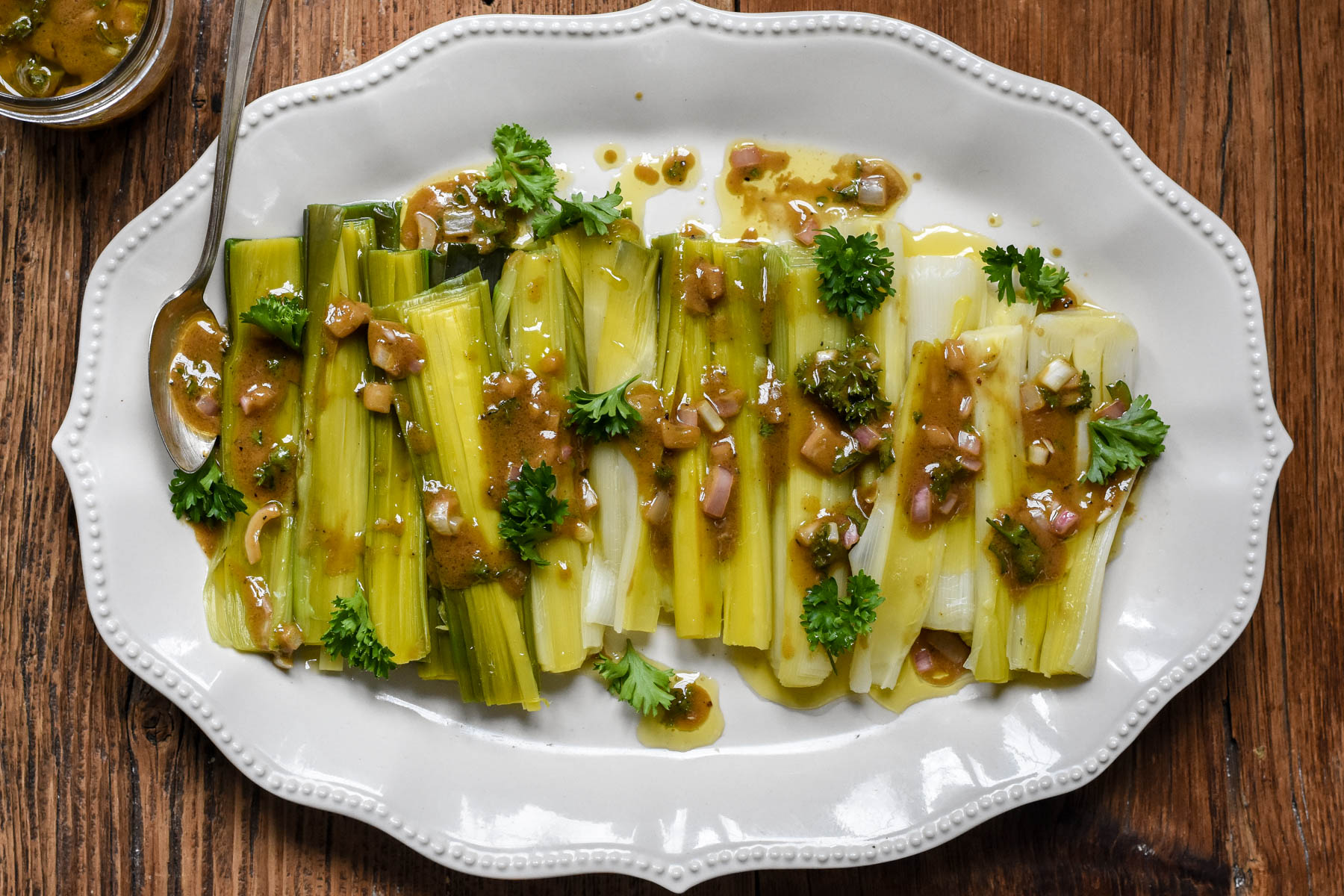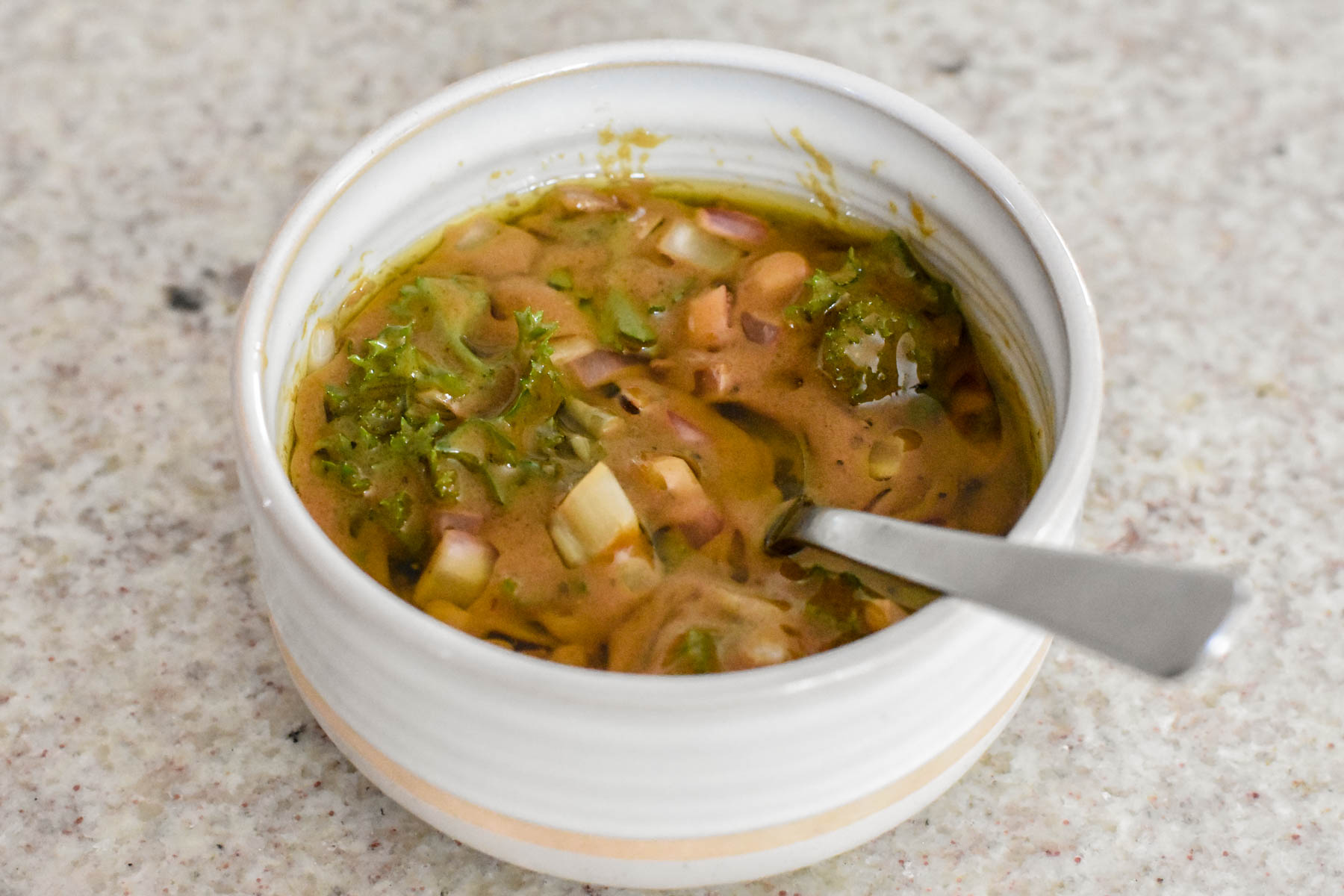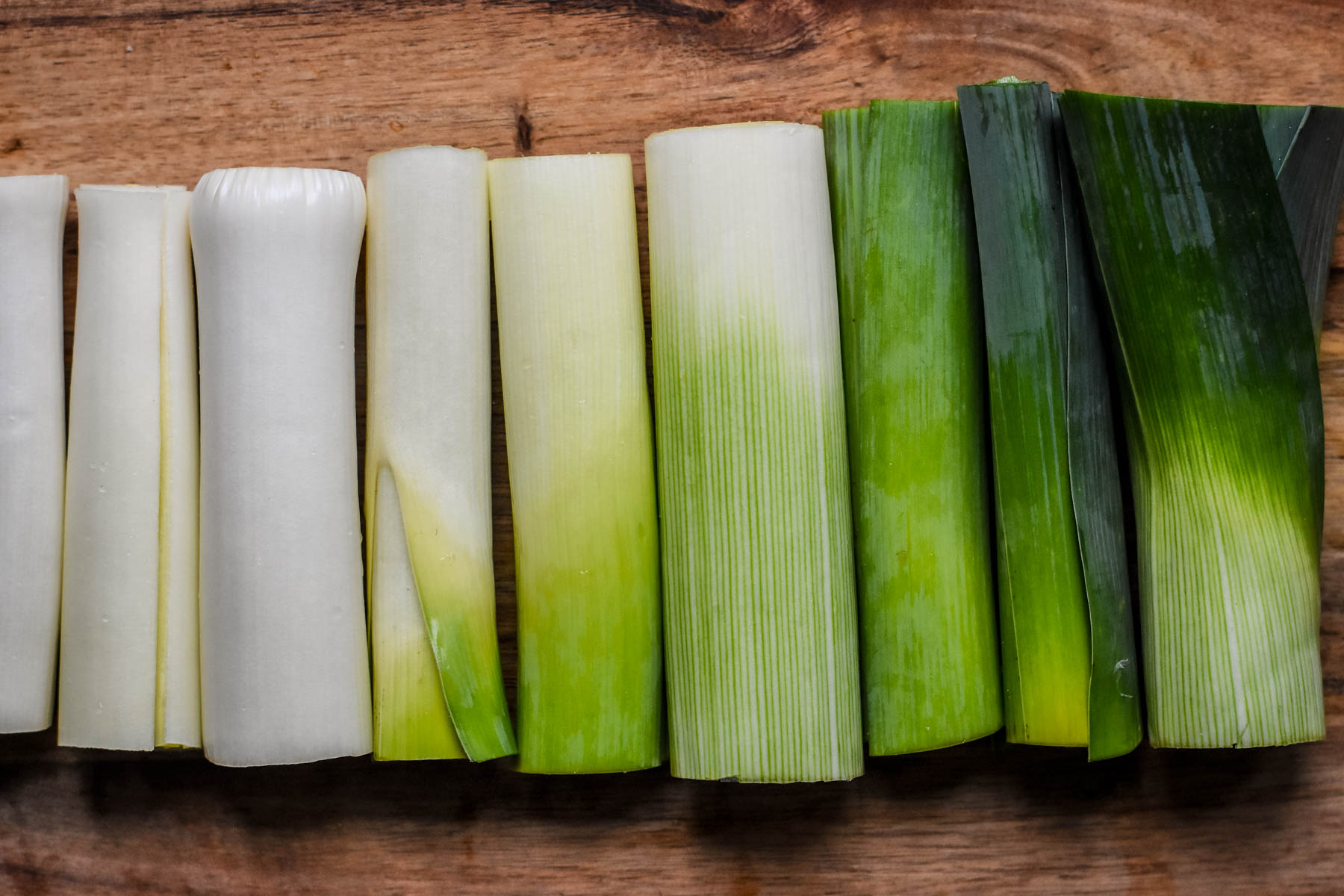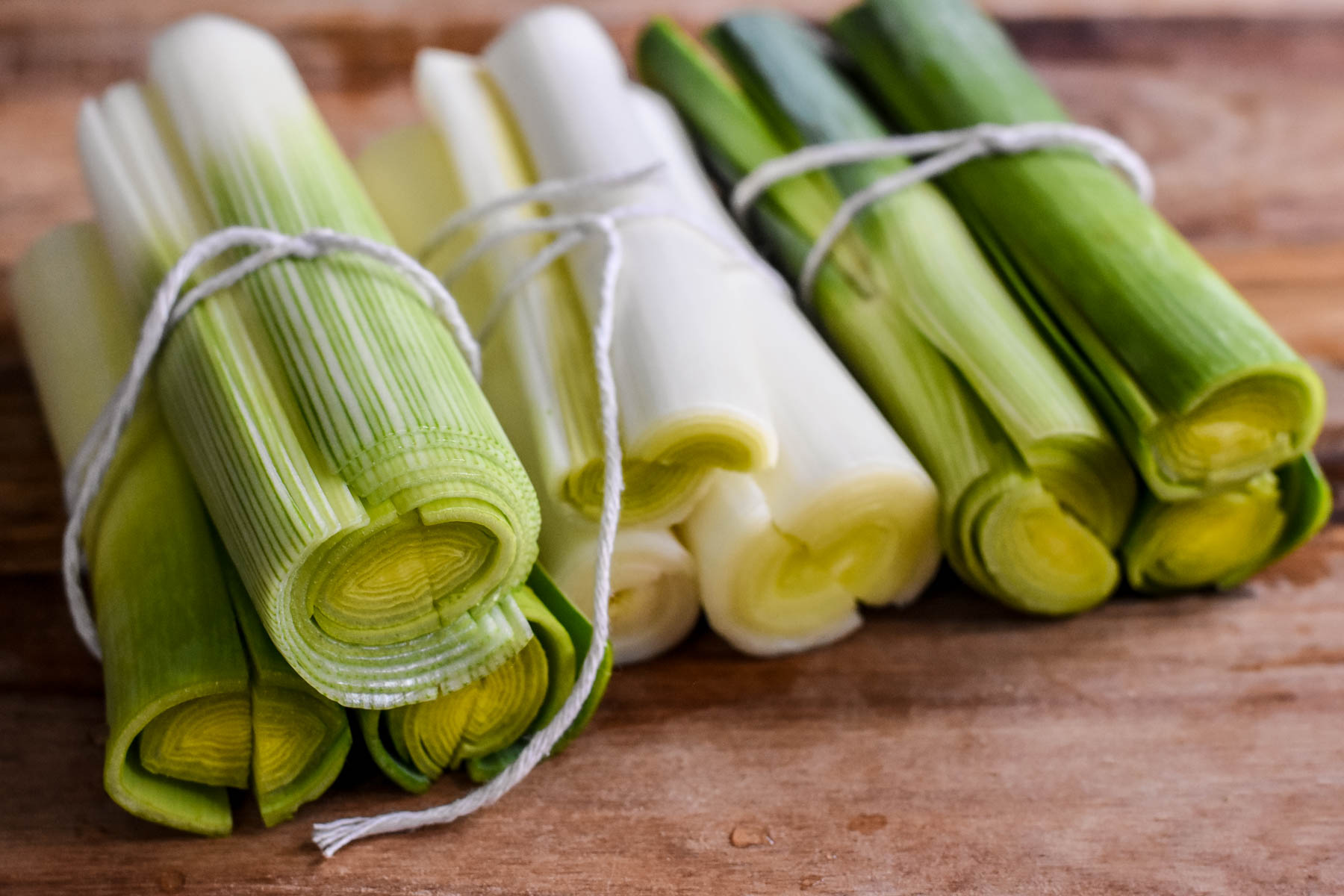BY
It also gives these seasonal alliums, often thought of as a supporting player, a well-deserved moment to shine.

The leeks only get better as they sit and absorb the vinaigrette. (Audrey Le Goff)
A Fresh Start
Poireaux vinaigrette belongs to a long list of classic cold starter salads, or entrées froides, that the French love to relish in the spring and summer.
Whether it’s carottes rapées (shredded carrots), salade de betteraves (beetroot salad), celeri rémoulade (celeriac remoulade), or poireaux vinaigrette, starting your meal with a small plate is almost like a ritual in France. It’s meant to open up your appetite and ensure you incorporate a healthy serving of vegetables into your meal.
These veggie-focused starters are mainstays of any French bistro menu, as well as staples of any home cook’s repertoire, as they’re usually quick and simple to make.
They’re as colorful as they are diverse in taste and preparation, but are all bound by a common component: the vinaigrette.

A tangy, herby, mustardy vinaigrette adds welcome zip and brightness. (Audrey Le Goff)
Secrets to a Good Vinaigrette
“Vinaigrette” is a diminutive form of the word “vinaigre,” meaning “vinegar.” This classic French salad dressing traditionally calls for one part vinegar to three parts olive oil. This combination of fat (oil) with acid (vinegar) is then whisked until emulsified, becoming denser and frothier in consistency.
Today, vinaigrettes often include additional components, such as mustard, shallots, and herbs, to add more flavor and character.
As simple as it is, a good vinaigrette can truly make a dish. It brings welcome zip and brightness to a dull bowl of mixed greens, and can turn an unassuming poached leek into a luxurious dish.
With that in mind, here are three tips to better understand and master the vinaigrette:
Order Matters
The list of ingredients for a vinaigrette is short and simple, but the order in which you add them actually matters. For the smoothest texture, it is important to whisk your salt into the vinegar first. Once the salt dissolves in the vinegar, you can then add your herbs, spices, and oil. If you add salt after adding the oil, it won’t dissolve and will remain suspended as unpleasant specks in the vinaigrette, giving it a gritty texture.
Take the Time to Emulsify
Emulsifying, technically speaking, is the process of forcing two liquid components that normally don’t mix—oil and vinegar—to bind together. This is done with the help of an emulsifier—the Dijon mustard—which will act as a bond between the oil and vinegar.
Start by adding the mustard to the (salted) vinegar. Then, slowly pour in the oil, whisking continuously, until the mixture is fully combined and starts to thicken. This step makes the vinaigrette silky-smooth and lightly creamy, and thus better able to coat your vegetables evenly.
Put Your Own Twist on It
Any vinaigrette-dressed vegetable recipe is one you can revisit over and over by putting different twists on it. You can substitute one or two ingredients, keeping the same measurements, or even add a few. Here are some suggestions:
The Oil: Substitute the extra virgin olive oil for a light, neutral-flavored oil like canola, avocado, or grapeseed oil. Or, try walnut oil for nutty notes.
The Vinegar: Substitute the red wine vinegar for a dark balsamic vinegar to create a sweeter, thicker, more syrupy vinaigrette. You can also use a white balsamic for a milder, slightly less-sweet version, or sherry vinegar for a more intense flavor.
The Aromatics: Substitute shallots for finely sliced scallions to add a fresh, grassy flavor. Raw onions aren’t recommended as a substitute, as they will be too harsh in flavor.
The Spices: Substitute—or complement—the black pepper with more surprising spices, like cinnamon or smoked paprika.
The Emulsifier: Substitute Dijon for whole-grain mustard for a more interesting texture, thanks to the whole seeds. Miso paste and tahini also make surprising but remarkable substitutes. Honey Dijon mustard isn’t recommended, as it is too sweet in flavor.
The Herbs: Parsley is just one of the few herbs you can use in a vinaigrette. Fresh dill, chives, tarragon, mint, and basil all make great substitutes or additions.
Delicious Extras: Salty fixings such as capers, finely chopped anchovies, anchovy paste, chopped sun-dried tomatoes, or finely diced olives are all great add-ons to a vinaigrette. Use no more than a tablespoon, so that their flavor is not overpowering. Other delicious options include chopped walnuts, chopped hard-boiled eggs, and grated or crumbled cheese.
Be creative—the possibilities are endless.
Spring Leeks
The arrival of spring is the perfect time to indulge in poireaux vinaigrette. Leek season runs from September through April, but spring leeks are smaller and more tender, which makes them ideal for this recipe.
Choose leeks with deep green leaves and pristine white ends. For this recipe, opt for leeks that are smaller in size, and leave bigger ones for soups or stews. Rinse them thoroughly, especially in between the leaves, and do not refrigerate them, or they’ll lose their delicate texture.

Choose leeks with deep green leaves and pristine white ends.
Poaching the leeks is an easy cooking method that helps bring out their sweetness, while giving them a smooth, almost buttery texture. Use twine to tie them in small bundles before cooking, so they don’t separate.
Poireaux vinaigrette is traditionally a first course, but don’t hesitate to enjoy it as a side with chicken or fish if you wish.
Here’s a tip: after being drizzled with vinaigrette, the leeks only get better as they sit and absorb the zippy dressing. You can prepare this dish a few hours in advance and let it rest at room temperature prior to serving.
Leeks in Dijon-Shallot Vinaigrette (Poireaux Vinaigrette)
Serves 4 as an appetizer
- 4 small leeks or 3 medium-sized leeks
- 1/2 teaspoon salt
For the vinaigrette:
- 2 tablespoons red wine vinegar
- 1/4 teaspoon salt
- 1 shallot, peeled and finely diced
- 1 tablespoon Dijon mustard
- 6 sprigs curly parsley, stemmed and roughly chopped
- 1/4 teaspoon freshly ground black pepper
- 6 tablespoons extra virgin olive oil
Cut off and discard the root ends and dark green tips of the leeks. Keep most of the light green parts, so you get a nice white-to-green gradient for the final dish. Discard any outer leaves that are too tough and/or blemished. Cut each leek into thirds, so you have 9 or 12 equal-sized pieces total, and then cut each piece in half lengthwise. Use butcher’s twine to tie all the pieces into three small bundles.

Kitchen twine keeps the bundles of leeks together as they cook. (Audrey Le Goff)
Bring a large pot of water to a boil. Add salt and place the bundles of leeks in the water so they are completely submerged. Bring back to a boil, cover with a lid, turn the heat down to medium-high, and boil for 20 minutes, until the leeks are fork-tender.

Poaching the leeks renders them soft and sweet. (Audrey Le Goff)
Meanwhile, prepare the vinaigrette. Combine the vinegar and salt in a bowl, and whisk with a fork for about 1 minute until the salt has dissolved. Add the shallot, mustard, parsley, and pepper. Then, slowly drizzle in the oil in a steady stream while constantly whisking. Continue whisking until the dressing thickens to your desired texture.
Remove the leek bundles from the water with a slotted spoon and let them cool and drain on a kitchen towel. If needed, squeeze out some of the excess water.
Place the leeks on a serving platter and cut off the twine. Top generously with the vinaigrette.
Serve warm or cool.

A tangy, herby, mustardy vinaigrette adds welcome zip and brightness.
Audrey Le Goff is a French food writer, photographer, and creator of the food blog Pardon Your French, where she shares recipes and stories from her beloved home country, France. She is the author of the cookbook “Rustic French Cooking Made Easy” (2019). She currently lives in Niagara, Canada. Follow her on Instagram @pardonyourfrench
Republished with Permission The Epoch Times SUBSCRIBE
Get Citizensjournal.us Headlines free SUBSCRIPTION. Keep us publishing – DONATE




